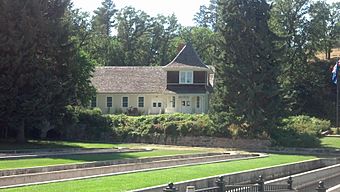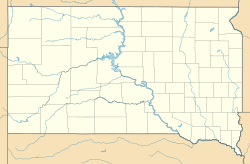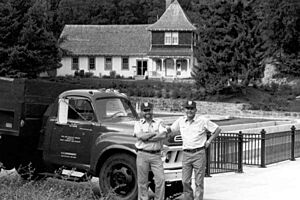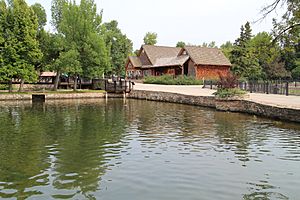D.C. Booth Historic National Fish Hatchery facts for kids
Quick facts for kids |
|
|
Spearfish Fisheries Center
|
|

The Von Bayer Museum at the Spearfish Fisheries Center.
|
|
| Nearest city | Spearfish, South Dakota |
|---|---|
| Area | 10 acres (4.0 ha) |
| Built | 1896 |
| Visitation | 155,000 (2012) |
| NRHP reference No. | 78003438 |
| Added to NRHP | May 19, 1978 |
The D.C. Booth Historic National Fish Hatchery and Archives is also known as the Spearfish Fisheries Center. It is one of the oldest fish hatcheries in the United States. This center is located near Spearfish, South Dakota. It was started in 1896 by the U.S. Fish and Wildlife Service.
The main goal was to bring and grow trout populations. These fish were released into the Black Hills of South Dakota and Wyoming. Today, the hatchery releases about 20,000 to 30,000 rainbow trout every year. The center also keeps old records and items about fish farming. It is listed on the National Register of Historic Places.
Contents
Exploring the Center's Buildings and Exhibits
The Von Bayer Museum: A Look at Fish Culture History
The Von Bayer Museum of Fish Culture is found inside the original hatchery building from 1899. This museum holds over 185,000 items related to fish farming. It is the largest collection of its kind in the United States. Only a few items are on display for visitors to see.
The Booth House: A Historic Home
The Booth House was built in 1905 by D.C. Booth. He was the first superintendent of the hatchery. This wooden house was his family home. It sits on a strong stone foundation. The house has been kept in good condition. Visitors can take tours to see what it was like.
Fish Car No. 3: Traveling with Trout
Fish Car No. 3 is a copy of an old train car. Before trucks with refrigerators, these cars moved trout across the Black Hills. Ten such cars were used for about 66 years. They helped transport fish and their eggs.
The Ice House: Storing Ice for Fish Transport
Near the fish car is a replica of the 1899 ice house. This building once stored large blocks of ice. The ice was used to keep fish and eggs cold during transport. Now, it is the Fish Culture Hall of Fame. It honors important people in aquaculture, which is fish farming.
The Yellowstone Boat: Collecting Trout Eggs
The Yellowstone Boat, or U.S. Fisheries Boat #39, was used for special trips. Fish hatchery workers used it to collect trout eggs. These trips happened in Yellowstone National Park from 1901 to 1911. The boat has been fixed up and is now on display.
Visitor Center and Fish Viewing Areas
The Pond Gift Shop and information center is in an old hatchery building. Visitors can use machines to feed the fish in the main viewing area. There is also a special area to watch fish underwater. Two hiking trails also run around the edges of the site.
History of the Spearfish Fisheries Center
How the Hatchery Got Started
The idea for this fish hatchery came from a bill passed by Congress. Hector Von Bayer was sent to find the best place for it. He chose Ames Canyon, south of Spearfish. A sawmill was there, but the owner sold the land.
H. A. Bush oversaw the building of the hatchery. John Russell did most of the construction work. A tough winter in 1898-1899 slowed things down. But the hatchery was finished by July 1899. It opened as the Spearfish National Fish Hatchery in 1896. It had 17 ponds and a main building. These used spring water to operate.
Early Challenges and Successes
In July 1899, 100,000 blackspotted trout eggs arrived. But a flash flood hit the area a few days later. All the eggs were washed away. Dewitt Clinton Booth, the first superintendent, then added two storm channels. These channels helped stop future floods.
Booth and his team cleaned up the area. They finished the hatchery building. It could hold up to 2.5 million eggs in 48 troughs. Booth said the winter conditions were good for the eggs to grow. The first trout were released in April 1900. About 25,000 blackspotted and brook trout went into Little Spearfish Creek and Whitewood Creek.
A year later, Loch Leven brown trout were put into a creek near Nemo. That fall, rainbow trout were stocked in Spearfish Creek and Iron Creek. Another flood happened in 1904. Booth then built ten-foot-high walls, called bulkheads, to protect the hatchery. Booth lived at the hatchery for 34 years.
Reopening and Continued Operations
The hatchery closed in 1983 because of budget cuts. It was still managed by the U.S. Fish and Wildlife Service. Visitors could still come, but fish operations stopped. The hatchery reopened in 1989. It was renamed the D.C. Booth Historic National Fish Hatchery to honor Booth. New partnerships helped it reopen. The hatchery was updated in 1995.
In August 2013, there was a plan to close the hatchery again. This was due to not enough money and other programs getting more attention. Many people, including local leaders, spoke out against the closure. Because of public efforts, the closure was stopped. The hatchery has continued its operations since then.
Tourism and Economic Benefits
The hatchery brings a lot of money to local businesses. A study from 2007 showed it creates $2.1 million in income each year. About $1 million is spent in Spearfish by visitors who come because of the hatchery. The Booth Society, a group that helps the hatchery, said that in 2011, every tax dollar supporting the hatchery brought $28 back to the community. The hatchery welcomes about 155,000 visitors each year.
See also
- List of National Fish Hatcheries in the United States
- National Register of Historic Places listings in Lawrence County, South Dakota




